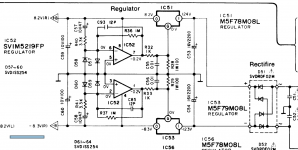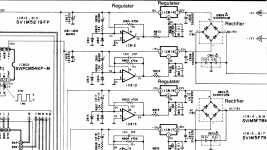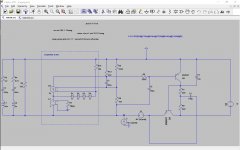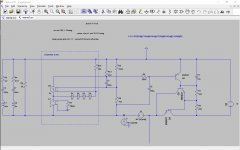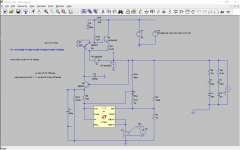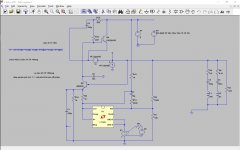Isn't a TL431 going to be noisier than a low-voltage zener? Maybe reducing noise is more desirable than a low dynamic impedance, given that by the operation of the LM317 its operating as a CCS from its Adj pin and any zener is already going to have an order of magnitude lower dynamic impedance than a resistor hanging from Adj.
(I have only just come to this thread, just thinking out loud here).
(I have only just come to this thread, just thinking out loud here).
Two kind of noises should be considered.
Hum: 120 Hz / 100Hz ripple.
Hiss: Thermal noise and flicker noise.
Hum: 120 Hz / 100Hz ripple.
Hiss: Thermal noise and flicker noise.
Last edited:
I liked Elvee's D-Noizator enough that I laid out a voltage regulator PCB which contains two D-Noizators. The board provides bipolar outputs (±X volts, where 11<X<20 is user adjustable) and can be fed from either a dual secondary transformer or an AC wall wart. I posted the Gerber files here on diyAudio; they are free and public domain. Anyone can download and use them.
D-Noizator uses a discrete transistor amplifier to drive the ADJ pin of an LM317 in just the right way, to increase PSRR and decrease output noise.
link to Elvee's D-Noizator
_
D-Noizator uses a discrete transistor amplifier to drive the ADJ pin of an LM317 in just the right way, to increase PSRR and decrease output noise.
link to Elvee's D-Noizator
_
Indeed, Elvee's D-Noizator over LM317, is a nice alternative.
I wonder how it compares with
LM317 + TL431
and
LM314 + Zener diode.
I wonder how it compares with
LM317 + TL431
and
LM314 + Zener diode.
I liked Elvee's D-Noizator enough that I laid out a voltage regulator PCB which contains two D-Noizators. The board provides bipolar outputs (±X volts, where 11<X<20 is user adjustable) and can be fed from either a dual secondary transformer or an AC wall wart. I posted the Gerber files here on diyAudio; they are free and public domain. Anyone can download and use them.
D-Noizator uses a discrete transistor amplifier to drive the ADJ pin of an LM317 in just the right way, to increase PSRR and decrease output noise.
link to Elvee's D-Noizator
you might be interested in technics regulators too:
_
Attachments
In this Technics regulators, I see the same trick used in the Elvee' s Denoisetor:
Sense the noise at the output, amplify then inject at the Adjust pin of the regulator.
I don't understand the -0.2V at the op amps outputs. Why not 0 ? and there is 0V marked at the regulator' s adjust pins.
Sense the noise at the output, amplify then inject at the Adjust pin of the regulator.
I don't understand the -0.2V at the op amps outputs. Why not 0 ? and there is 0V marked at the regulator' s adjust pins.
Must be the offset from Ibias. I had not found which op amp is used.I have no idea...it might be some offset and there's 3ua bias current over 1megohm resistor for m5219 anyway...here's a different better version that has some mistakes in it:
Last schematic looks the same, but with no offset, could that be, they use a JFET input op amp here. 27pF compensation caps are missing.
Isn't a TL431 going to be noisier than a low-voltage zener? Maybe reducing noise is more desirable than a low dynamic impedance, given that by the operation of the LM317 its operating as a CCS from its Adj pin and any zener is already going to have an order of magnitude lower dynamic impedance than a resistor hanging from Adj.
(I have only just come to this thread, just thinking out loud here).
Isn't a TL431 going to be noisier than a low-voltage zener? Maybe reducing noise is more desirable than a low dynamic impedance, given that by the operation of the LM317 its operating as a CCS from its Adj pin and any zener is already going to have an order of magnitude lower dynamic impedance than a resistor hanging from Adj.
(I have only just come to this thread, just thinking out loud here).
Yes, TL431 is noisier than low voltage low noise zener diodes. TL431 is 120 nV/√ over 1KHz, 220nV/√ at 10Hz. Zener diodes widely depends, asking for a careful selection to make sure about a lower noise.
I wish to know more about zener diodes.
the op-amp is the same, probably the panasonic version of mitsubishi m5219(bipolar, low noise, powerful)/.They just missed some notations here and there.SLP-1000 has 470k//27pf, slp-990 has 1meg//12pf.Obviously the slp-1000 has half the output offset, whatever it may be...I built their regulators with some minor mods , didn't have the time to fire it.Must be the offset from Ibias. I had not found which op amp is used.
Last schematic looks the same, but with no offset, could that be, they use a JFET input op amp here. 27pF compensation caps are missing.
Last edited:
OT: That Mitsubishi m5219 looks interesting, with +/-22.5V supply recommended. High output.
Jan
Jan
M5220 is even better.Both m5219 and 5220 were used in some of the best cassette players as the first playback stage op-amp and as i/v converter in some high end jvc cd-players. There were made especially for phono preamps as they can take max +-25v supply.Unfortunately extinct as many other good things over the time.Every time i get a scraped cassette deck i look for m5220.
Last edited:
Two plain LM317 (no TL431) in a row, one after another, solves most the problems discussed here.
I have tried three in a row - the result is "tube sound", clean crisp, from preamplifier.
Anyway thanks for very interesting discussion and measurements.
I have tried three in a row - the result is "tube sound", clean crisp, from preamplifier.
Anyway thanks for very interesting discussion and measurements.
There are so many ways for hum to sneak in, some not invented yet 😉, that tons of cascaded LM317 is no answer.
- Home
- Amplifiers
- Power Supplies
- LM317+TL431, really?
